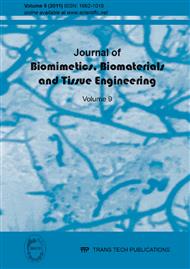[1]
M.P. Duckworth, T. Iezzi and W.T. O'donohue: Motor vehicle collisions: medical, psychosocial, and legal consequences (Academic Press, United States 2008).
Google Scholar
[2]
M.J. VAN DER HORST: Human head neck response in frontal, lateral and rear end impact loading modelling and validation (Ph.D., Eindhoven University of Technology, Netherlands 2002), pp.1-8.
Google Scholar
[3]
A.M. Pearson, M.M. Panjabi and P.C. Ivancic: Spine, Vol. 30 (2005) No. 16, pp.1852-1858.
Google Scholar
[4]
M.M. Panjabi, A.M. Pearson and S. Ito: Spine, Vol. 29 (2004) No. 21, pp.2395-2403.
Google Scholar
[5]
P.C. Ivancic, A.M. Pearson and Y. Tominaga: Spine, Vol. 32 (2007) No. 22, pp.2467-2473.
Google Scholar
[6]
V. Esat, D.W. Van Lopik and M. Acar: IUTAM Symposium on Impact Biomechanics: From Fundamental Insights to Applications (Dublin, Ireland, July 11-15, 2005). Vol. 124, pp.91-100.
DOI: 10.1007/1-4020-3796-1_9
Google Scholar
[7]
S. Himmetoglu, M. Acar and A.J. Taylor: Proceedings of the Institution of Mechanical Engineers, Part D: Journal of Automobile Engineering, Vol. 221 (2007) No. 5, pp.527-541.
DOI: 10.1243/09544070jauto467
Google Scholar
[8]
D.W. Van Lopik, M. Acar: International Journal of Crashworthiness, Vol. 9 (2004) No. 5, pp.465-473.
Google Scholar
[9]
D.W. Van Lopik, M. Acar: Proceedings of the Institution of Mechanical Engineers, Part K: Journal of Multi-body Dynamics, Vol. 221 (2007) No. 2, pp.175-197.
DOI: 10.1243/14644193jmbd84
Google Scholar
[10]
D.W. Van Lopik, M. Acar: Proceedings of the Institution of Mechanical Engineers, Part K: Journal of Multi-body Dynamics, Vol. 221 (2007) No. 2, pp.199-217.
DOI: 10.1243/14644193jmbd89
Google Scholar
[11]
A. Veloso, G. Esteves and S. Silva: International Association of Science and Technology for Development Proceedings of the 24th IASTED International Conference on Biomedical Engineering (Innsbruck, Austria, February 15-17, 2006). pp.401-407.
Google Scholar
[12]
S.M. Kim, I.C. Yang and M.P. Lee: IFMBE Proceedings, Vol. 14 (2007) No. 4, pp.2521-2524.
Google Scholar
[13]
L.X. Guo, M. Zhang and Z.W. Wang: Computers in Biology and Medicine, Vol. 38 (2008) No. 1, pp.146-151.
Google Scholar
[14]
Z.P. Li, J.E. Alonso and J.E. Kim: Annals of Biomedical Engineering, Vol. 34 (2006) No. 9, pp.1452-1462.
Google Scholar
[15]
H. Yu, M.B. Medri and Q. Zhou: International Journal of Crashworthiness, Vol. 9 (2004) No. 2, pp.175-186.
Google Scholar
[16]
P. Tropiano, L. Thollon and P.J. Arnoux: Spine, Vol. 29 (2004) No. 16, pp.1709-1716.
Google Scholar
[17]
E.C. Teo, Q.H. Zhang and T.X. Qiu: International Conference on Biomedical and Pharmaceutical Engineering (Singapore, Singapore, December 11-14, 2006). pp.206-209.
Google Scholar
[18]
E.C. Teo and H.W. Ng: Journal of Biomechanics, Vol. 34 (2001) No. 1, pp.13-21.
Google Scholar
[19]
H.W. Ng, E.C. Teo and Q.H. Zhang: Proceedings of the Institution of Mechanical Engineers, Part H: Journal of Engineering in Medicine, Vol. 218 (2004) No. 3, pp.183-191.
Google Scholar
[20]
Q.H. Zhang, S.H. Tan and E.C. Teo: Proceedings of the Institution of Mechanical Engineers, Part H: Journal of Engineering in Medicine, Vol. 222 (2008) No. 5, pp.781-790.
Google Scholar
[21]
M.J. Fagan, S. Julian and A.M. Mohsen: Proceedings of the Institution of Mechanical Engineers, Part H: Journal of Engineering in Medicine, Vol. 216 (2002) No. 5, pp.281-298.
Google Scholar
[22]
W.Z. Golinski and R. Gentle: Proceedings of the Institution of Mechanical Engineers, Part D: Journal of Automobile Engineering, Vol. 219 (2005) No. 2, pp.197-205.
Google Scholar
[23]
N. Yoganandan, S. Kumaresan and F.A. Pintar: Journal of Biomechanical Engineering, Vol. 122 (2000) No. 6, pp.623-629.
Google Scholar
[24]
N. Yoganandan, F.A. Pintar and J. Zhang: Annals of Biomedical Engineering, Vol. 36 (2008) No. 3, pp.406-414.
Google Scholar
[25]
N. Yoganandan, F. A Pintar and D.J. Maiman: Traffic Injury Prevention, Vol. 10 (2009) No. 1, pp.51-57.
Google Scholar
[26]
B.D. Stemper, N. Yoganandan and F.A. Pintar: Medical and Biological Engineering and Computing, Vol. 42 (2004) No. 3, pp.333-338.
Google Scholar
[27]
W. Hell, S. Schick and K. Langwieder: Traffic Injury Prevention, Vol. 3 (2002) No. 2, pp.127-140.
Google Scholar
[28]
J. Latchford, E.C. Chirwa and T. Chen: Proceedings of the Institution of Mechanical Engineers, Part D: Journal of automobile engineering, Vol. 219 (2005) No. 11, pp.1293-1302.
DOI: 10.1243/095440705x34946
Google Scholar
[29]
M.M. Panjabi, P.C. Ivancic and Y. Tominaga: Traffic Injury Prevention, Vol. 6 (2005) No. 4, pp.387-397.
Google Scholar
[30]
P.C. Ivancic, S. Ito and M.M. Panjabi: Traffic Injury Prevention, Vol. 6 (2005) No. 2, pp.175-184.
Google Scholar
[31]
M.M. Panjabi, P.C. Ivancic and T.G. Maak: Spine, Vol. 31 (2006) No. 4, pp.420-429.
Google Scholar
[32]
M. Fukushima, K. Kaneoka and K Ono: Spine, Vol. 31 (2006) No. 8, pp.903-908.
Google Scholar
[33]
J.W. Lee, H. Yoon K and G.J. Park: Proceedings of the Institution of Mechanical Engineers, Part D: Journal of Automobile Engineering, Vol. 217 (2002) No. 1, pp.23-29.
Google Scholar
[34]
C.R. Gentle, W.Z. Golinski and F. Heitplatz: Proceedings of the Institution of Mechanical Engineers, Part H: Journal of Engineering in Medicine, Vol. 215 (2001) No. 2, pp.181-189.
DOI: 10.1243/0954411011533742
Google Scholar
[35]
B.S. Zuckerbraun, K. Morrison and B. Gaines: Journal of Pediatric Surgery, Vol. 39 (2004) No. 3, pp.483-486.
Google Scholar
[36]
R.K. Wilcox: Proceedings of the Institution of Mechanical Engineers, Part H: Journal of Engineering in Medicine, Vol. 220 (2006) No. 4, pp.565-572.
Google Scholar
[37]
R.J. Oakland, R.M. Hall and R.K. Wilcox: Proceedings of the Institution of Mechanical Engineers, Part H: Journal of Engineering in Medicine, Vol. 220 (2006) No. 4, pp.489-492.
Google Scholar
[38]
E.M.K.P. Barros, C.J. Rodrigues and N.R. Rodriguez: The Spine Journal, Vol. 2 (2002) No. 1, pp.57-62.
Google Scholar
[39]
P.C. Ivancic, M.P. Coe and A.B. Ndu: The Spine Journal, Vol. 7 (2007) No. 6, pp.659-665.
Google Scholar
[40]
A. Truta, F.A. Pop and M. Arghir: ANNALS of the ORADEA UNIVERSITY, Fascicle of Management and Technological Engineering, Vol. 7 (2008) No. 17, pp.1149-1152.
Google Scholar
[41]
J.D. Bronzino: The Biomedical Engineering Handbook (CRC Press LLC, United States 2000).
Google Scholar
[42]
Information on http: /www. lifemodeler. com/LM_Manual.
Google Scholar


